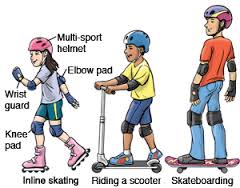Skating and skateboarding can increase balance, agility, coordination and reaction time. It’s also pretty fun. With plenty of practice and these safety tips, your kids can roll smart and safe.
Protective equipment is a a must.
Every skater should wear a helmet. Wrist guards, knee pads and elbow pads are a good idea for everyone, but especially for beginners. Mouth guards are good protection against broken teeth. Make sure the helmet fits (Helmet Safety) and your child knows how to put in on correctly.

- EYES check: Position the helmet on your head. Look up and you should see the bottom rim of the helmet. The rim should be one to two finger-widths above the eyebrows.
- EARS check: Make sure the straps of the helmet form a "V" under your ears when buckled. The strap should be snug but comfortable.
- MOUTH check: Open your mouth as wide as you can. Do you feel the helmet hug your head? If not, tighten those straps and make sure the buckle is flat against your skin.
Be Smart about skating.
- According to the American Academy of Pediatrics (AAP), children under 5 should never ride a skateboard. This might seem overly protective, but a child’s balance and judgment have not fully developed yet, which means a high risk for a serious injury.
- Buy skates that truly fit in order to make learning easier and safer for your child.
- Limit skating to bike paths or areas set aside in public parks. Children should ride on smooth, dry surfaces located in a well-lit area away from traffic. Streets should be off-limits, as most in-line skating fatalities involve collisions with motor vehicles.
- Teach children to minimize the impact of a fall by crouching down as they lose balance to reduce the distance to the surface.
- Teach kids to check skates and boards for problems before each use. If there are any cracked, loose or broken parts, the item should not be used until it is repaired.
- Different skates and different boards do different things, so make sure kids have the right gear for their activity.
Learn how to fall.
Learning how to fall may help reduce the chances of a serious injury.
- If you are losing your balance, crouch down so that you will not have as far to fall.
- In a fall, the idea is to land on the fleshy parts of your body.
- If you fall, try to roll rather than absorb the force with your arms.
- Even though it may be difficult during a fall, try to relax your body, rather than go stiff.
- Practice falling on a soft surface or grass.
Other Tips
- Never skate in the street.
- Obey the city laws – observe traffic and areas where you can and cannot skate.
- Don't skate in cards of non-skaters.
- Only one person per skateboard
- Never hitch a ride from a car, bicycle, etc.
- Don't take chances; complicated tricks require careful practice and a specially-designated area.
- Consider taking lesson from a trained instructor or experienced skater.
- Know how to turn, control speed, stop and skate with your head up so you can recognize and avoid obstacles.
- Each time you head out, warm up with a gentle 5-minute skate and stretches.
- Don't skate while wearing headphones. Listening to music while skating will make it difficult to hear traffic, pedestrians, or other skaters.
- Skate with a friend. This will not only be more fun, but you'll also be able to look out for one another. Skate in a single-file line
*Sources: National Safety Council (www.nsc.org) and Safe Kids Worldwide (www.safekids.org)*
